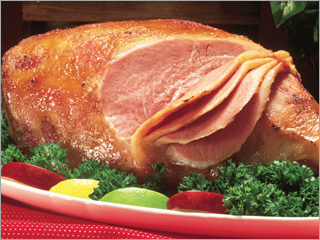Carry me back to old Virginny . . the smells of Smithfield Ham
There was one food that will eternally signal my childhood. It represented both our place in Virginia society and our taste as a family. The food of my childhood was the smoky, briny, heavenly flavor and texture of Smithfield Ham. “Smithfield,” while a brand name, came to identify the whole category of aged, cured Virginia hams that are part of this story. Nothing like the bland picnic hams or the “Honey-baked spiral cut hams” of today, this fragrant, intense meat is worthy of reverence. The early settlers undoubtedly are greatly to be thanked for their ingenuity in dealing with the problems of keeping meat viable without refrigeration. This legacy didn’t mean very much to me as a 10 year old in Richmond, but the smell and taste of this extravagant meat will always remind me of my family life. I owe those settler women a big debt of thanks, as well as those who still cure these hams today.
Every Christmas and Thanksgiving occasioned the great acquisition. The ham was a big deal. We’d buy an 11-14 lb. ham, wrapped in a brown cotton wrapper. I remember my Granny remarking how expensive it was. I have a vague memory of her becoming irate when the price per pound went over $1.5O. So, I guess this whole ham leg cost $16 to $20 in the 1950’s. Today, this same ham (which is still available by mail order) runs around $7 or $8 a lb. A good sized one of these can easily cost $100+ with shipping. These hams had been cured for up to 12 years, I believe, according to the advertising.
The big deal began when Granny would unwrap the raw ham and prepare it for cooking. First it had to be soaked overnight . . . or for days, or forever, it seemed to me. I could never understand why you paid a fortune for a salty ham, but then needed to soak it to reduce the salt content, but, well. . . my Granny did know the best way to do this. Everyone said so. After the interminable soaking, the ham was dried and then prepared for baking. The naked ham would be covered in something very sweet, I’m pretty sure it was brown sugar and melted butter, since it created a crunchy crust of a sort. Oh, but first, the fatty skin of the ham was “scored” in a cross hatch pattern. Then the brown sugar was plastered on, followed by inserting a fragrant clove into the intersection of each cross hatch. I’d often get the job of pushing in the cloves . . . rather like putting push pins on a bulletin board. Then, rings of pineapple and shiny maraschino cherries were added for color and drama.
Then, the ham baked in the oven for what seemed a very long time. The smell of this exotic, salty pork cooking, encased by the sweetness of the brown sugar crust is possibly the happiest sense memory of all time for me. FINALLY it came out of the oven and, of course, needed to sit for a while for all the juices to distribute properly. Ah, and then at last we’d cut into this divine dish.
The carving needed to be precise. “Cut it thin, thin, very thin . . . paper thin, if you can,” my Granny Ryan would intone. As the flavor was truly intense a little went a long, long way. The ham had to be cut in just the right direction, starting at the small end, and on a slight angle. As the carving progressed the slices got wider in girth, but if it was done correctly the slices were very thin.
We ate this precious meat in several ways, typically. It was served as warmed ham biscuits. The biscuits were sometimes store bought: shiny Parker house rolls, made with an egg batter and ever so slightly sweet. These were slathered with fresh, sweet butter and warmed slightly with the thin sliced ham stuffed inside. Or sometimes Granny would make baking soda biscuits from scratch to pocket them. My favorite was the Smithfield Ham sandwich: white bread, mayonnaise and thin slices of this wonderful, wonderful delicacy. Occasionally we’d add some crunchy, iceberg lettuce, but there was always a debate about what was really the perfect way to eat this ham.
It was a brilliant breakfast food, too. When slices of this were slightly fried they became even more intense and were a dramatic pairing with creamy, scrambled eggs. When we got down to the bone of it, we’d scrape the tiny bits and chop them up finely to be added to scrambled eggs or to a scalloped potato recipe.
When we came to the end of the ham there were often numerous odd shaped pieces, some with that luscious fatty, sugary crust. This was the time that Granny got out her meat grinder and screwed it to the Formica kitchen table for ballast. All the twiddly bits were mashed into the grinder and Granny would churn away . . . making a large bowl of minced ham. This mixed with mayonnaise and sometimes a little chopped pickle was the last evidence that the holiday was coming to an end.
You can still order these hams. The internet has made it easy to track down the genuine article. (http://www.smithfieldham.com) I think I’ll send off for a 14 pound raw Smithfield Ham. Now, my only problem is: where on earth can I find a manual meat grinder these days?
Patricia Ryan Madson
This article was written in 2002 as an assignment for a class titled: "Food and Memory". I was studying food writing.
Patricia Ryan Madson
This article was written in 2002 as an assignment for a class titled: "Food and Memory". I was studying food writing.

No comments:
Post a Comment